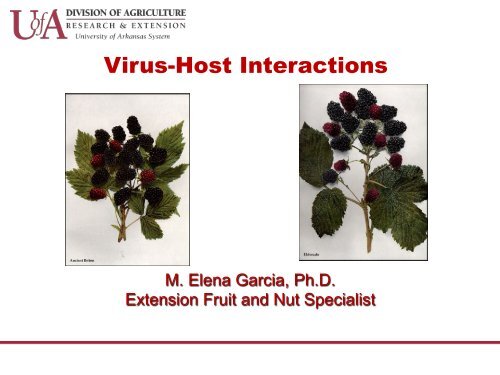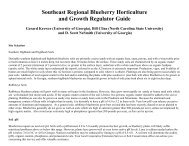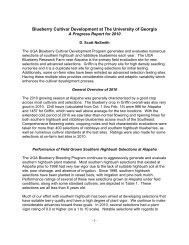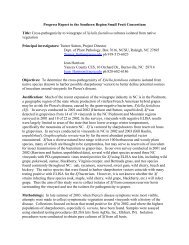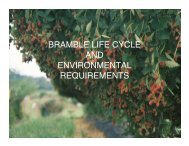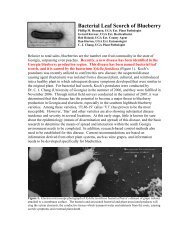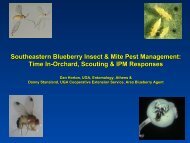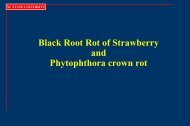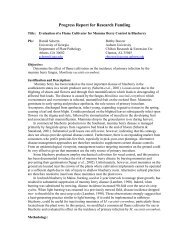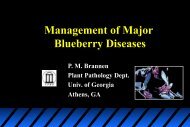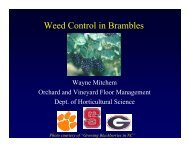Virus-Host Interactions
Virus-Host Interactions
Virus-Host Interactions
You also want an ePaper? Increase the reach of your titles
YUMPU automatically turns print PDFs into web optimized ePapers that Google loves.
<strong>Virus</strong>-<strong>Host</strong> <strong>Interactions</strong>M. Elena Garcia, Ph.D.Extension Fruit and Nut Specialist
<strong>Virus</strong>es• Infectious pathogens• Non-cellular• Not active outside the cell• Obligate parasites– Small piece of nucleic acids surrounded by aprotein coat– Depend on host’s machinery to reproduce• Infect all types of living organisms, butmost infect only one type of host
History• 1882- Adolf Mayer:Transmission of tobacco mosaicdisease by plant extract– Infectious agent could not beisolated• 1892- Dimitri Ivanofsky:Causative agent of tobacco isnot retained by filters– Cannot be cultivated in vitro• 1898 Martinus Beijerinck:Causative agent can becultivated in live tissue
Morphology• Composed of two principal parts– Genome• Nucleic acid (NA)– Protective shell (coat)• Protein• Capsid– Some viruses have an outer membrane• Lipoprotein membrane
Plant viruses• Two protein shell types– Helical (elongated)• Rigid rods• Flexuous filaments• NA is highly ordered: helical confirmation (asproteinaceous capsid)– Icosahedral• Baccilliform• Two incomplete icosahedral• NA forms a partially ordered ball inside the capsid
Rigid rodsFlexuous filamentsicosahedralbacilliformTwin virions composed of two joinedincomplete icosahedra
<strong>Virus</strong> Types• Helical- the NA is highly ordered: itassumes the same helical conformation asthe proteinaceous capsid.• Icosahedral the genomic NA forms apartially ordered ball inside theproteinaceous capsid.• Self-assembly in a test tube if the NA andprotein subunits are incubated underproper conditions.
Genome Types• Single stranded (ss), positivesenseRNA– Bromoviridae, Letroviridae• Cucumovirus• Single stranded negativesenseRNA– Bunyaviridae• Double-stranded RNA– Reoviridae
Genome Types• dsDNA– Pararetroviruses– Caulimoviridae– Replication involvesand RNA intermediate• ssDNA– Geminiviridae– dsDNA intermidiate
Systematics• First plant virus was purified and classifiedin mid 1930’s• <strong>Virus</strong> named after host plant and symptom– Tobacco mosaic virus- TMV• Largest subdivisions– Chemical form of genome• Genera and families derived from animportant within the family– Brome mosaic virus
Plant <strong>Virus</strong>es- General• Approximately 1000 different plantviruses• Losses due to plant viruses ~ $ 6 x10 10• Do not have specific cellular receptorsto enter cell– Relay on mechanical breaches of cell’sintegrity– Vectors– Mechanical damage
Entrance• Many plant viruses have evolved specializedmovement proteins which modify theplasmodesmata.– One of the best known examples of this is the30k protein of tobacco mosaic virus (TMV).This protein is expressed from a sub-genomicmRNA and its function is to modifyplasmodesmata causing genomic RNA coatedwith 30k protein to be transported from theinfected cell to neighboring cells.
Transmission of Plant <strong>Virus</strong>es• Seeds• Vegetative propagation• Mechanical• Vectors– Bacteria– Fungi– Nematodes– Arthropods– Arachnids- mites
Reproduction• Passive entrance into cytoplasm• Removal of protein coat• Cell mediated expression of viral genome– Transcription apparatus (DNA viruses)– Translation apparatus (all viruses)• Proteins• DNA viruses must be transported to thenucleus
• Viron enters cytoplasm passively• Partial or complete removal of coat proteinin the cytoplasm• Mediation of expression of viral genomeby providing the transcription apparatusand translation apparatus
ProteinThree types of proteins• Replication proteins for nucleic acidproduction• Structural protein for protein shell• Movement protein for transport betweencells
The replication cycle of Tobacco mosaic virus (TMV). TMV enters a wounded plant cell to begin thereplication cycle [1]. As the coat protein (CP) molecules are stripped away from the RNA [2], hostribosomes begin to translate the two replicase-associated proteins. The replicase proteins (RP) areused to generate a negative-sense (- sense) RNA template from the virus RNA [3]. This - sense RNAis, in turn, used to generate both full-length positive-sense (+ sense) TMV RNA [4] and the + sensesubgenomic RNAs (sgRNAs) [5] that are used to express the movement protein (MP) and CP. The +sense TMV RNA is either encapsidated by the CP to form new TMV particles [6] or wrapped with MP[7] to allow it to move to an adjacent cell for another round of replication (Drawing courtesy VickieBrewster: from K.-B. G. Scholthof 2000).
Cell-to-cell movement of Tobacco mosaic virus (TMV). In this model, the movement protein(MP) binds to the viral RNA [1]. <strong>Host</strong> proteins and/or other virus-encoded proteins may beincluded in the MP-complex [2]. The MP-complex then moves from cell-to-cell through theplasmodesmata [3]. When the complex is localized to a new cell, the MP (and any hostproteins) are presumably released from the TMV RNA [4], allowing for translation of thegenomic RNA to express the replicase proteins and to initiate a new round of replication [5].(Drawing courtesy Vickie Brewster: from K.-B. G. Scholthof 2000).
Morphological Symptoms• Symptoms range from symptomlessconditions to severe disease and plantdeath– Chlorosis and necrosis- direct damage due tovirus replication– Hypoplasia- localized retarded growth-leadsto mosaicism– Hyperplasia- excessive cell division- distortedareas
Chlorosis• Symptoms associated with disruption ofchloroplast structure, function, and/ordevelopment• Yellowed areas in expanded leaves thatdeveloped before infection• Mosaic pattern in leaves that developedafter infection
ChlorosisPeanut mottle virus in bean, chlorotic lesions on leaf(Courtesy C.W. Kuhn)Squash leaf curl virus in summer squash, vein banding symptom(Courtesy R. Providenti)Rubus yellow net virus
Hyperplasia• -Excessive cell division- distorted areas
Necrosis• Hypersensitive response (HR)• Different response from bacterial and fungiinduced HR– Plant recognizes and respond to intracellulargene product– Mutations frequently change the phenotypefrom virulence to avirulence
Hypersensitive Response• Synthesis of new proteins- pathogenesisrelated• Increased production of cell wall phenolics• Release of active oxygen species• Production of phytoalexins• Accumulation of salicylic acid
Plant ResistanceResistance different levels and variousmechanisms• Immunity- complete resistance– Prevents viral replication– Non-host resistance– Extreme resistance• Subliminal infection– Replication, but virus prevented from movingoutside the cell
Plant Resistance• Hypersensitive response– Kills cells within infected area– Prevents spreading of infection– Systemic acquired resistance (SAR)• Pathogen non-specific resistance
Plant-<strong>Virus</strong> <strong>Interactions</strong>Plants possess active and passive means toprevent infectionPassive• Failure to host factors necessary for virusreproductionActive• Detection and destruction of virus-infectedcells– Resistance genes–
Symptoms• Symptoms range from symptomlessconditions to severe disease and plantdeath– Chlorosis and necrosis- direct damage due tovirus replication– Hypoplasia- localized retarded growth-leadsto mosaicism– Hyperplasia- excessive cell division- distortedareas
Chlorosis• Symptoms associated with disruption ofchloroplast structure, function, and/ordevelopment• The mosaic pattern that develops in a leafappears not to depend upon its position,but rather on the stage of leafdevelopment at the time of viral infection– Yellowed areas in expanded leaves thatdeveloped before infection– Mosaic pattern in leaves that developed afterinfection
Necrosis1.- Hypersensitive response (HR)- Usuallycontrolled by single dominant gene• Different response from bacterial and fungiinduced HR– Plant recognizes and respond to intracellulargene product– Mutations frequently change the phenotypefrom virulence to avirulence
Hypersensitive Response• Synthesis of new proteins- pathogenesisrelated• Increased production of cell wall phenolics• Release of active oxygen species• Production of phytoalexins• Accumulation of salicylic acid
Necrosis2.- Slower-forming local necrosis that is notrelated to a single host gene3.- Various degrees of systemic necrosis• Not clear if responses are distinctlydifferent or variations of the same process• Race between how fast the virusreplicates and moves and how fast the HRoccurs
Systemic AcquiredResistance (SAR)• Systemic acquired resistance (SAR) is aplant immune response to pathogenattack.• SAR is analogous to the innate immunesystem found in animals, and there isevidence that SAR in plants and innateimmunity in animals may be evolutionarilyconserved.
SAR• Initiated through a local interaction amongpattern-recognition receptors to recognizeconserved microbial signatures and resultsin accumulation of phytohormones such assalicylic acid and jasmonic acid, ethylene,H 2 O 2, at the distant tissues
• Plant Immune Responses Against <strong>Virus</strong>es: How Does a <strong>Virus</strong> CauseDisease. Kranthi K. Mandadi and Karen-Beth G. Scholthof1
Summary• Plant viruses are diverse and unusualgroups of plant pathogens that infect andcause disease in many crop plants.– Pathogens depend on the normal cellularmachinery of their plant host for reproduction,it is difficult to eliminate them withoutdamaging the host plant.– Management strategies for diseases causedby plant viruses and viroids are directed atpreventing infection of the plant.


